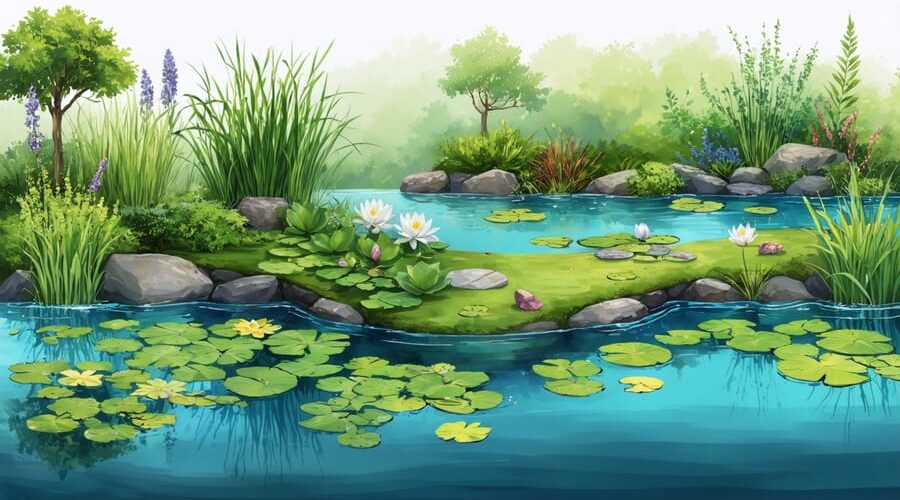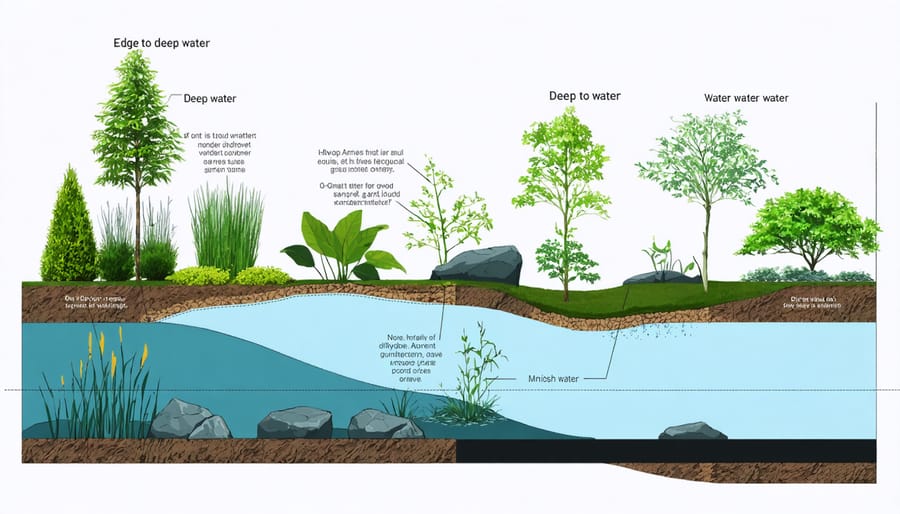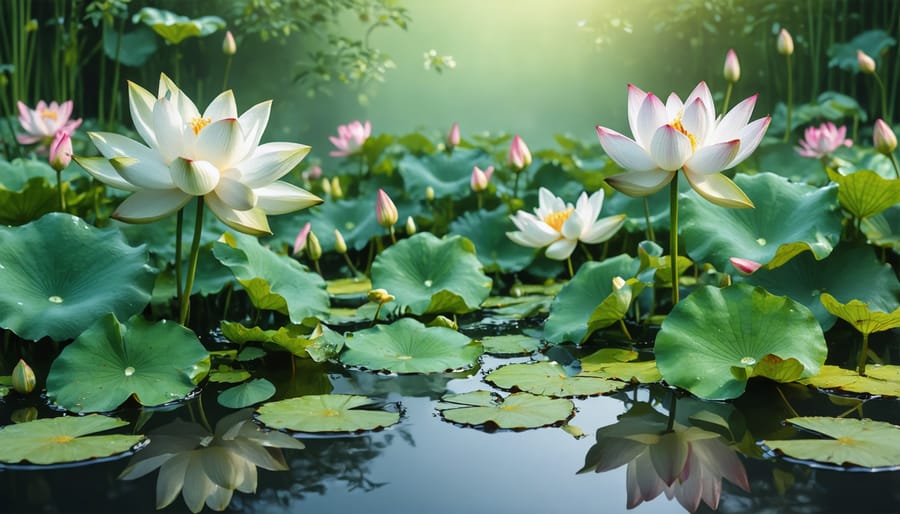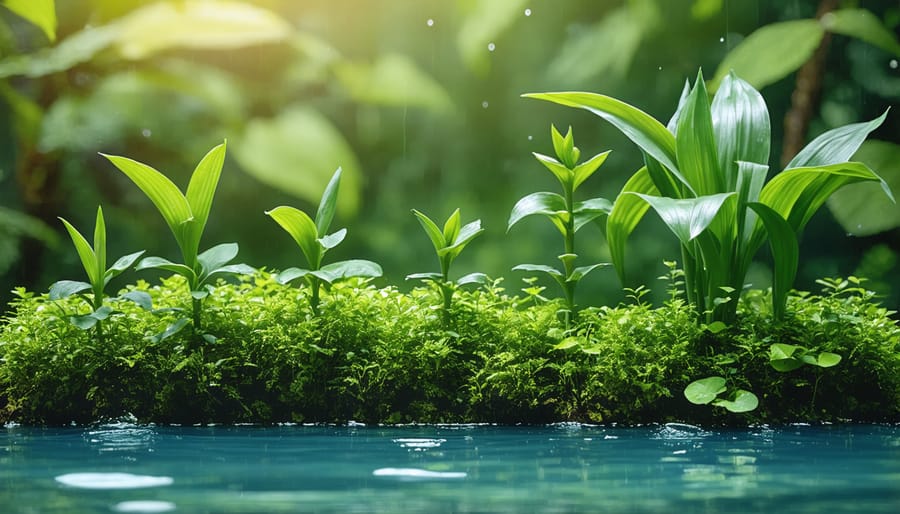
Transform Your Water Garden with These Perfect Plant Choices
Transform your water garden into a thriving aquatic paradise by mastering the essential elements of creating a balanced ecosystem. Water plants serve as natural filters, oxygen producers, and vital habitat creators in any aquatic environment. Position marginal plants like rushes and iris at the pond’s edge to stabilize banks and provide vertical interest, while floating varieties such as water lilies cover 60-70% of the water’s surface to regulate temperature and reduce algae growth. Deep-water plants anchor into submerged pots filled with aquatic soil, creating crucial layers of vegetation that support fish and beneficial microorganisms. Understanding these distinct planting zones – shallow marginal, deep marginal, floating, and submerged – enables gardeners to develop rich, self-sustaining water gardens that flourish throughout the seasons. By carefully selecting plants for each zone and maintaining proper water chemistry, your aquatic garden will evolve into a dynamic ecosystem that requires minimal intervention while providing maximum beauty and environmental benefits.

Understanding Water Garden Zones
Marginal Plants
Marginal plants create a beautiful transition between your pond and the surrounding landscape, growing in shallow water or moist soil along the water’s edge. Popular choices include iris, cattails, and rush plants, which not only add visual interest but also help stabilize the pond’s banks. These plants provide essential shelter for wildlife and help filter excess nutrients from the water. When planting marginals, use aquatic baskets filled with heavy clay-based soil and position them so the crown sits just above water level. For the best display, group similar species together and vary the heights to create depth. Many marginal plants spread readily, so consider placing barriers to control their growth or regularly divide them to maintain the desired size and shape of your water garden.
Deep Water Plants
Deep water plants, also known as submergent plants, thrive in the deepest parts of your pond, typically in areas 2 to 5 feet deep. Water lilies are the stars of this category, offering stunning blooms that float on the surface while their roots anchor deep below. These plants help maintain water quality by providing shade and reducing algae growth.
Popular deep water varieties include the classic Hardy Water Lily, which comes in colors ranging from pure white to deep pink, and the tropical Water Lotus, known for its majestic flowers and distinctive seed pods. Submerged oxygenators like Hornwort and Anacharis are essential companions, as they release oxygen into the water and provide shelter for pond life.
When planting in deep water, use specially designed planting baskets filled with aquatic soil, and gradually lower them to their final depth over several days to help the plants adjust. Most deep water plants will flourish when planted in spring, giving them time to establish before winter.
Floating Plants
Floating plants add a natural, enchanting layer to any water garden while providing essential shade and protection for aquatic life below. Popular varieties like water lettuce and duckweed spread across the water’s surface, creating a carpet-like effect that helps reduce algae growth by limiting sunlight penetration. Water hyacinth, with its beautiful lavender blooms, not only adds visual interest but also helps filter excess nutrients from the water. These plants require minimal maintenance – simply place them on the water’s surface, and they’ll naturally multiply over time. For best results, remove excess growth periodically to prevent overcrowding, and ensure about 40-60% of your water surface remains covered. During winter, bring tender floating plants indoors in colder regions, as most can’t survive freezing temperatures. Their root systems hanging beneath the surface provide excellent hiding spots for fish fry and help maintain a balanced ecosystem in your water garden.
Best Plants for Each Zone
Shallow Water Favorites
Shallow water zones offer the perfect environment for some of the most stunning best plants for water gardens. Water lilies are the undisputed stars of this zone, with their elegant floating leaves and vibrant blooms that open during daylight hours. Hardy varieties like the ‘Attraction’ and ‘Colorado’ perform exceptionally well in depths between 6-24 inches.
Marsh marigolds bring cheerful yellow flowers to the water’s edge in spring, while pickerelweed offers beautiful purple spikes throughout summer. These plants are practically foolproof for beginners and create excellent hiding spots for small fish. Sweet flag (Acorus calamus) adds vertical interest with its sword-like leaves and brings a lovely vanilla scent to your garden.
Don’t overlook the charming water forget-me-not, which creates a carpet of tiny blue flowers just above the water’s surface. For those seeking something more dramatic, try the umbrella palm – it’s easy to grow and adds a tropical touch to any water feature.
These shallow water favorites not only look beautiful but also help maintain water quality by absorbing excess nutrients. Most thrive in full sun to partial shade and establish quickly, making them perfect for new pond owners. Just remember to plant them in specially designed aquatic baskets filled with heavy garden soil, topped with gravel to prevent soil from floating away.
Deep Water Classics
For those looking to add drama and beauty to the deeper sections of their water garden, several classic aquatic plants have proven themselves time and time again. Water lilies reign supreme in this category, offering both stunning blooms and essential surface coverage. These gorgeous plants thrive in water depths between 18 and 72 inches, making them perfect for larger ponds and water features.
Another reliable deep-water favorite is the lotus, with its majestic flowers rising well above the water surface and its distinctive seed pods adding winter interest. While lotuses need plenty of space to spread, they’re surprisingly easy to maintain once established.
The underwater workhorse, Anacharis, deserves special mention for its ability to oxygenate deep water while creating essential fish habitat. This plant grows in graceful strands and helps maintain crystal-clear water conditions naturally.
Don’t overlook the impressive American pondweed, which adapts beautifully to various water depths and provides excellent coverage for aquatic life. It’s particularly valuable for wildlife ponds, offering shelter for fish fry and aquatic insects.
These deep-water classics not only create stunning visual impact but also play crucial roles in maintaining pond health through natural filtration and oxygen production. When planning your water garden, combining several of these tried-and-true varieties will help create a balanced, thriving ecosystem.

Surface Coverage Options
Floating plants add a beautiful dimension to your water garden while providing essential benefits like shade and natural filtration. Water lilies are classic favorites, offering stunning blooms in various colors while their broad leaves create perfect cover for fish. For smaller spaces, water hyacinths work wonderfully, producing lovely purple flowers and forming dense mats that help reduce algae growth.
Duckweed, though tiny, can create a delicate green carpet across your water’s surface. While it multiplies quickly, it’s easily managed and provides excellent nutrition for fish. For something more distinctive, try water lettuce with its velvety, rosette-shaped leaves that create an attractive tropical feel.
Frogbit is another excellent choice, featuring heart-shaped leaves that float gracefully on the surface. It’s less aggressive than duckweed but still provides good coverage. For partial coverage that allows some sunlight to penetrate, consider fairy moss (Azolla), which creates a beautiful reddish-purple carpet in strong light.
Remember to maintain about 60-70% surface coverage for optimal pond health. This balance allows enough light for submerged plants while preventing excessive algae growth. In winter, reduce floating plants to prevent decay, and in summer, thin them regularly to maintain proper coverage. Each of these plants brings its own charm while contributing to your water garden’s ecosystem.
Plant Growth and Maintenance
Planting Techniques
Successfully establishing water plants requires careful attention to planting techniques and proper placement. Start by choosing the right container for your water plants – mesh baskets or solid pots designed specifically for aquatic plants work best. These containers should have plenty of drainage holes to allow water circulation while keeping the soil in place.
When preparing your planting medium, use heavy garden soil or aquatic plant soil rather than regular potting mix, which tends to float. Avoid using soil with added fertilizers or chemicals that could harm fish or disturb the water’s balance. Fill your container about two-thirds full with the soil mixture.
Position your plant in the container and add more soil around the roots, being careful not to bury the crown (where the stems meet the roots) of the plant. Leave about an inch of space at the top of the container for a layer of gravel or small stones. This top layer helps prevent soil from floating away and keeps fish from digging in the substrate.
For deep-water plants like water lilies, gradually lower them to their final depth over several weeks. Start by placing them in shallow water and slowly move them deeper as they establish. Most marginal plants should be positioned so their crowns are just at or slightly above water level.
Remember to remove any yellowing or dead leaves during planting, and trim roots if they appear damaged or overly long. Once planted, add slow-release aquatic fertilizer tablets according to package instructions to give your plants the nutrients they need to thrive. With proper planting techniques, your water garden plants will establish strong root systems and provide beautiful growth throughout the season.

Seasonal Care Tips
Caring for water plants requires different approaches throughout the year to ensure healthy growth and vibrant displays. In spring, start by removing dead foliage and dividing overcrowded plants as they begin to show new growth. This is also the perfect time to add slow-release aquatic fertilizer tablets to give your plants a strong start for the growing season.
Summer brings peak growth, requiring regular maintenance to keep your water garden thriving. Monitor water levels closely, as increased temperatures lead to higher evaporation rates. Trim yellowing leaves promptly and remove spent blooms to encourage continuous flowering. Watch for algae growth and maintain proper water circulation to prevent stagnation.
As autumn approaches, reduce fertilization gradually and remove fallen leaves before they sink and decompose. This is crucial for preventing excess nutrients that could lead to algae problems the following spring. For tropical water plants, plan their move indoors before the first frost if you live in a cold climate.
Winter care varies depending on your hardiness zone. In mild climates, hardy water plants can remain in deep water, below the freeze line. In colder regions, move tender plants indoors to a cool, bright location. If keeping plants outside, prevent the water from freezing solid by using a pond heater or bubble aerator.
Remember to maintain consistent water quality throughout the year by regularly testing pH levels and removing debris. Adjust your maintenance routine based on your local climate and the specific needs of your water plants. This seasonal approach ensures your water garden remains healthy and beautiful year-round.
Common Problems and Solutions
Even the most dedicated water gardeners face challenges with their aquatic plants. Understanding these common issues and knowing how to address them can make the difference between a thriving water garden and a struggling one. Let’s explore some typical problems and their solutions.
Algae overgrowth is perhaps the most frequent challenge. When nutrients are abundant and sunlight is intense, algae can quickly take over your water feature. Combat this by maintaining proper plant coverage (about 60% of the water surface), using beneficial bacteria, and ensuring proper filtration.
Many water gardeners struggle with yellowing leaves, which often indicates nutrient deficiency. Using the right aquatic plant fertilizer tablets and ensuring proper planting depth can resolve this issue. Remember to fertilize during the growing season but avoid over-fertilizing, which can lead to water quality problems.
Root rot and fungal infections are among the common pond plant diseases that can affect your water garden. Good circulation and proper spacing between plants help prevent these issues. If you notice mushy roots or unusual spots on leaves, remove affected parts and treat with appropriate aquatic-safe fungicides.
Poor growth or stunted plants often result from incorrect planting depths or inadequate light. Each water plant species has specific depth requirements – floating plants need surface access, while deep-water plants require specific depths to thrive. Ensure your plants receive 4-6 hours of direct sunlight daily for optimal growth.
Lastly, seasonal transitions can be challenging. Protect tender plants from frost by moving them to deeper water in winter. In summer, prevent leaf burn by gradually acclimating new plants to full sun. Regular monitoring and quick response to problems will help maintain a healthy water garden throughout the year.
Creating a water garden with thriving plants is an exciting and rewarding journey that can transform your outdoor space into a peaceful oasis. By understanding the different planting zones, choosing the right plants for your conditions, and maintaining proper care routines, you’ll be well on your way to a successful water garden. Remember that starting small and gradually expanding your collection allows you to learn and adapt as you go. Whether you’re drawn to the elegant beauty of water lilies, the practical benefits of oxygenating plants, or the visual interest of marginal species, there’s a perfect combination waiting for your water feature. Take time to observe your garden’s conditions, experiment with different plant varieties, and most importantly, enjoy the process of bringing life to your water garden. Your aquatic paradise awaits!
